Day 2: Rockin' in Plymouth
Main Page > 1998 Oh My Cod !!! Its New England Tour ! >
The next morning the Boys awoke refreshed and ready for more abuse despite the copious amount of Scotch Mike and Bone sucked down the night before. AHHH the qualities of a fine single malt scotch! Since Bone had been married to a witch and they were in the neighborhood, Mike and Bone decided head south and back to Massachusetts to check out Ellen's ancestral roots in Salem!
Slummin' in Salem

What were the Salem Witch Trials all about !?! What was the Salem Witch Trials all about !?! From June through September of 1692, nineteen men and women, all having been convicted of witchcraft, were carted to Gallows Hill, a barren slope near Salem for hanging. Another man of over eighty years was pressed to death under heavy stones for refusing to submit to a trial on witchcraft charges. Hundreds of others faced accusations of witchcraft. Dozens languished in jail for months without trials. Then, almost as soon as it had begun, the hysteria that swept through Puritan Massachusetts ended.
Why did this travesty of justice occur? Why did it occur in Salem? Nothing about this tragedy was inevitable. Only an unfortunate combination of an ongoing frontier war, economic conditions, congregational strife, teenage boredom, and personal jealousies can account for the spiraling accusations, trials, and executions that occurred in the spring and summer of 1692.
Salem Town Meetin' Place

What the heck really happened in Salem? What the heck really happened ? In 1688, John Putnam, one of the most influential elders of Salem Village, invited Samuel Parris, formerly a marginally successful planter and merchant in Barbados, to preach in the Village church. A year later, after negotiations over salary, inflation adjustments, and free firewood, Parris accepted the job as Village minister. He moved to Salem Village with his wife Elizabeth, his six-year-old daughter Betty, niece Abigail Williams, and his Indian slave Tituba, acquired by Parris in Barbados.
The Salem that became the new home of Parris was in the midst of change: a mercantile elite was beginning to develop, prominent people were becoming less willing to assume positions as town leaders, two clans (the Putnam's and the Porters) were competing for control of the village and its pulpit, and a debate was raging over how independent Salem Village, tied more to the interior agricultural regions, should be from Salem, a center of sea trade.
Sometime during February of the exceptionally cold winter of 1692, young Betty Parris became strangely ill. She dashed about, dove under furniture, contorted in pain, and complained of fever. The cause of her symptoms may have been some combination of stress, asthma, guilt, boredom, child abuse, epilepsy, and delusional psychosis. The symptoms also could have been caused, as Linda Caporael argued in a 1976 article in Science magazine, by a disease called "convulsive ergotism" brought on by ingesting rye--eaten as a cereal and as a common ingredient of bread--infected with ergot. (Ergot is caused by a fungus which invades developing kernels of rye grain, especially under warm and damp conditions such as existed at the time of the previous rye harvest in Salem.
Convulsive ergotism causes violent fits, a crawling sensation on the skin, vomiting, choking, and--most interestingly--hallucinations. The hallucinogenic drug LSD is a derivative of ergot.) Many of the symptoms or convulsive ergotism seem to match those attributed to Betty Parris, but there is no way of knowing with any certainty if she in fact suffered from the disease--and the theory would not explain the afflictions suffered by others in Salem later in the year.
Talk of witchcraft increased when other playmates of Betty, including eleven-year-old Ann Putnam, seventeen-year-old Mercy Lewis, and Mary Walcott, began to exhibit similar unusual behavior. When his own nostrums failed to effect a cure, William Griggs, a doctor called to examine the girls, suggested that the girls' problems might have a supernatural origin. The widespread belief that witches targeted children made the doctor's diagnosis seem increasing likely.
By this time, suspicion had already begun to focus on Tituba, who had been known to tell the girls tales of omens, voodoo, and witchcraft from her native folklore.
Meanwhile, the number of girls afflicted continued to grow, rising to seven with the addition of Ann Putnam, Elizabeth Hubbard, Susannah Sheldon, and Mary Warren. According to historian Peter Hoffer, the girls "turned themselves from a circle of friends into a gang of juvenile delinquents." ( Many people of the period complained that young people lacked the piety and sense of purpose of the founders' generation.) The girls contorted into grotesque poses, fell down into frozen postures, and complained of biting and pinching sensations. In a village where everyone believed that the devil was real, close at hand, and acted in the real world, the suspected affliction of the girls became an obsession.
Downtown Salem Town!

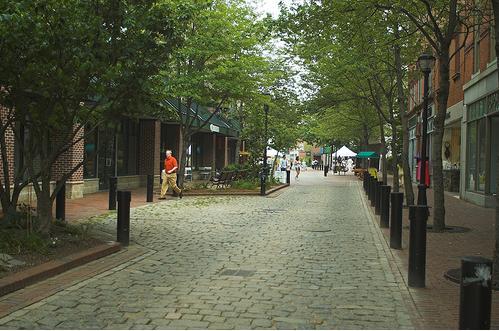
Sometime after February 25 and February 29, when arrest warrants were issued against Tituba and two other women, Betty Parris and Abigail Williams named their afflictors and the witch-hunt began. The consistency of the two girls' accusations suggests strongly that the girls worked out their stories together.
Soon Ann Putnam and Mercy Lewis were also reporting seeing "witches flying through the winter mist." The prominent Putnam family supported the girls' accusations, putting considerable impetus behind the prosecutions.
The first three to be accused of witchcraft were Tituba, Sarah Good, and Sarah Osborn. Tituba was an obvious choice, Good was a beggar and social misfit who lived wherever someone would house her, and Osborn was old, quarrelsome, and had not attended church for over a year. The Putnam's brought their complaint against the three women to county magistrates Jonathan Corwin and John Hathorne, who scheduled examinations for the suspected witches for March 1, 1692 in Ingersoll's tavern. When hundreds showed up, the examinations were moved to the meeting house. At the examinations, the girls described attacks by the specters of the three women, and fell into their by then perfected pattern of contortions when in the presence of one of the suspects. Other villagers came forward to offer stories of cheese and butter mysteriously gone bad or animals born with deformities after visits by one of the suspects. The magistrates, in the common practice of the time, asked the same questions of each suspect over and over: Were they witches? Had they seen Satan? How, if they were not witches, did they explain the contortions seemingly caused by their presence? The style and form of the questions indicates that the magistrates thought the women guilty.
The matter might have ended with admonishments were it not for Tituba. After first adamantly denying any guilt, afraid perhaps of being made a scapegoat, Tituba claimed that she was approached by a tall man from Boston--obviously Satan--who sometimes appeared as a dog or a hog and who asked her to sign in his book and to do his work. Yes, Tituba declared, she was a witch, and moreover she and four other witches, including Good and Osborn, had flown through the air on their poles. She had tried to run to Reverend Parris for counsel, she said, but the devil had blocked her path. Tituba's confession succeeded in transforming her from a possible scapegoat to a central figure in the expanding prosecutions. Her confession also served to silence most skeptics, and Parris and other local ministers began witch hunting with zeal.
Salem Witchcraft Memorial
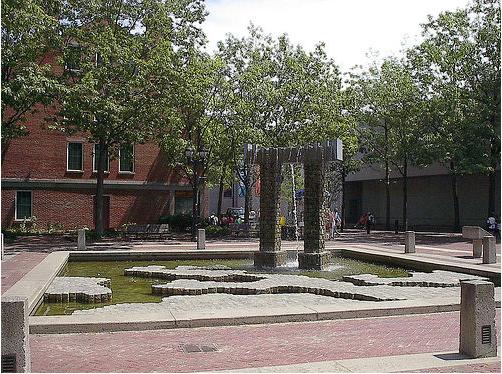
Soon, according to their own reports, the spectral forms of other women began attacking the afflicted girls. Martha Corey, Rebecca Nurse, Sarah Cloyce, and Mary Easty were accused of witchcraft. During a March 20 church service, Ann Putnam suddenly shouted, "Look where Goodwife Cloyce sits on the beam suckling her yellow bird between her fingers!" Soon Ann's mother, Ann Putnam, Sr., would join the accusers. Dorcas Good, four-year-old daughter of Sarah Good, became the first child to be accused of witchcraft when three of the girls complained that they were bitten by the specter of Dorcas. (The four-year-old was arrested, kept in jail for eight months, watched her mother get carried off to the gallows, and would "cry her heart out, and go insane.") The girls accusations and their ever more polished performances, including the new act of being struck dumb, played to large and believing audiences.
Stuck in jail with the damning testimony of the afflicted girls widely accepted, suspects began to see confession as a way to avoid the gallows. Deliverance Hobbs became the second witch to confess, admitting to pinching three of the girls at the Devil's command and flying on a pole to attend a witches' Sabbath in an open field. Jails approached capacity and the colony "teetered on the brink of chaos" when Governor Phips returned from England. Fast action, he decided, was required.
Phips created a new court, the "court of oyer and terminer," to hear the witchcraft cases. Five judges, including three close friends of Cotton Mather, were appointed to the court. Chief Justice, and most influential member of the court, was a gung-ho witch hunter named William Stoughton. Mather urged Stoughton and the other judges to credit confessions and admit "spectral evidence" (testimony by afflicted persons that they had been visited by a suspect's specter). Evidence that would be excluded from modern courtrooms-- hearsay, gossip, stories, unsupported assertions, surmises-- was also generally admitted. Many protections that modern defendants take for granted were lacking in Salem: accused witches had no legal counsel, could not have witnesses testify under oath on their behalf, and had no formal avenues of appeal. Defendants could, however, speak for themselves, produce evidence, and cross-examine their accusers. The degree to which defendants in Salem were able to take advantage of their modest protections varied considerably, depending on their own acuteness and their influence in the community.
Witchcraft Memorial Testimonial
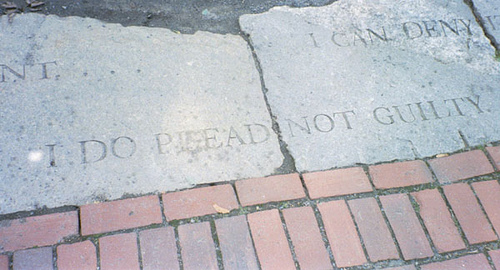
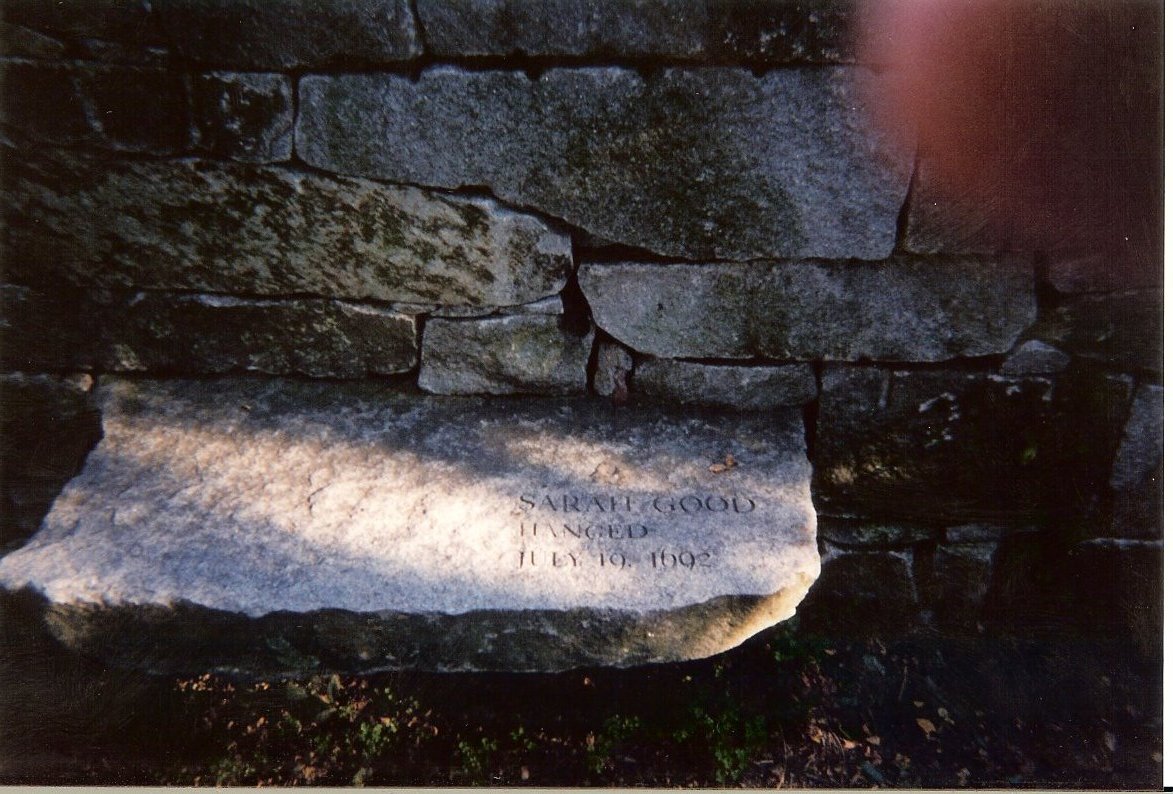
The first accused witch to be brought to trial was Bridget Bishop. Almost sixty years old, owner of a tavern where patrons could drink cider ale and play shuffleboard (even on the Sabbath), critical of her neighbors, and reluctant to pay her bills, Bishop was a likely candidate for an accusation of witchcraft. The fact that Thomas Newton, special prosecutor, selected Bishop for his first prosecution suggests that he believed the stronger case could be made against her than any of the other suspect witches. At Bishop's trial on June 2, 1692, a field hand testified that he saw Bishop's image stealing eggs and then saw her transform herself into a cat. Deliverance Hobbs, by then probably insane, and Mary Warren, both confessed witches, testified that Bishop was one of them. A villager named Samuel Grey told the court that Bishop visited his bed at night and tormented him. A jury of matrons assigned to examine Bishop's body reported that they found an "excrescence of flesh." Several of the afflicted girls testified that Bishop's specter afflicted them. Numerous other villagers described why they thought Bishop was responsible for various bits of bad luck that had befallen them. There was even testimony that while being transported under guard past the Salem meeting house, she looked at the building and caused a part of it to fall to the ground. Bishop's jury returned a verdict of guilty. One of the judges Nathaniel Saltonstall, aghast at the conduct of the trial, resigned from the court. Chief Justice Stoughton signed Bishop's death warrant, and on June 10, 1692, Bishop was carted to Gallows Hill and hanged.
As the summer of 1692 warmed, the pace of trials picked up. Not all defendants were as disreputable as Bridget Bishop. Rebecca Nurse was a pious, respected woman whose specter, according to Ann Putnam, Jr. and Abagail Williams, attacked them in mid March of 1692. Ann Putnam, Sr. added her complaint that Nurse demanded that she sign the Devil's book, then pinched her. Nurse was one of three Towne sisters, all identified as witches, who were members of a Topsfield family that had a long-standing quarrel with the Putnam family. Apart from the evidence of Putnam family members, the major piece of evidence against Nurse appeared to be testimony indicating that soon after Nurse lectured Benjamin Houlton for allowing his pig to root in her garden, Houlton died. The Nurse jury returned a verdict of not guilty, much to the displeasure of Chief Justice Stoughton, who told the jury to go back and consider again a statement of Nurse's that might be considered an admission of guilt (but more likely an indication of confusion about the question, as Nurse was old and nearly deaf). The jury reconvened, this time coming back with a verdict of guilty.
On July 19, 1692, Nurse rode with four other convicted witches to Gallows Hill.
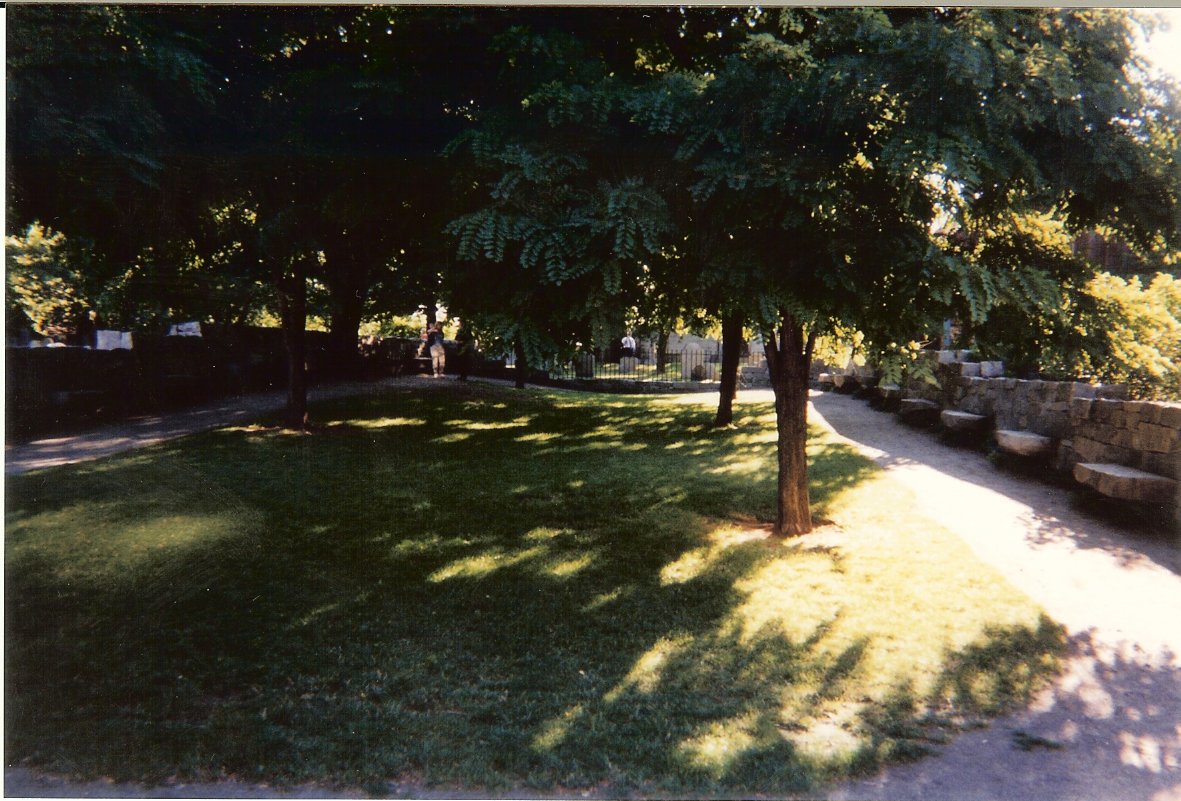
Persons who scoffed at accusations of witchcraft risked becoming targets of accusations themselves. One man who was openly critical of the trials paid for his skepticism with his life. John Proctor, was an opinionated tavern owner who openly denounced the witch-hunt. Testifying against Proctor were Ann Putnam, Abagail Williams, Indian John (a slave of Samuel Parris who worked in a competing tavern), and eighteen-year-old Elizabeth Booth, who testified that ghosts had come to her and accused Proctor of serial murder. Proctor fought back, accusing confessed witches of lying, complaining of torture, and demanding that his trial be moved to Boston. The efforts proved futile. Proctor was hanged. His wife Elizabeth, who was also convicted of witchcraft, was spared execution because of her pregnancy (reprieved "for the belly").
No execution caused more unease in Salem than that of the village's ex-minister, George Burroughs. Burroughs, who was living in Maine in 1692, was identified by several of his accusers as the ringleader of the witches. Ann Putnam claimed that Burroughs bewitched soldiers during a failed military campaign against Wabanakis in 1688-89, the first of a string of military disasters that could be blamed on an Indian-Devil alliance. In her interesting book, In the Devil's Snare, historian Mary Beth Norton argues that the large number of accusations against Burroughs, and his linkage to the frontier war, is the key to understanding the Salem trials. Norton contends that the enthusiasm of the Salem court in prosecuting the witchcraft cases owed in no small measure to the judges' desire to shift the "blame for their own inadequate defense of the frontier." Many of the judges, Norton points out, played lead roles in a war effort that had been markedly unsuccessful.
Among the thirty accusers of Burroughs was nineteen-year-old Mercy Lewis, a refugee of the frontier wars. Lewis, the most imaginative and forceful of the young accusers, offered unusually vivid testimony against Burroughs. Lewis told the court that Burroughs flew her to the top of a mountain and, pointing toward the surrounding land, promised her all the kingdoms if only she would sign in his book (a story very similar to that found in Matthew 4:8). Lewis said, "I would not writ if he had throwed me down on one hundred pitchforks." At an execution, a defendant in the Puritan colonies was expected to confess, and thus to save his soul. When Burroughs on Gallows Hill continued to insist on his innocence and then recited the Lord's Prayer perfectly (something witches were thought incapable of doing), the crowd reportedly was "greatly moved." The agitation of the crowd caused Cotton Mather to intervene and remind the crowd that Burroughs had had his day in court and lost.
One victim of the Salem witch-hunt was not hanged, but rather pressed under heavy stones until his death. Such was the fate of octogenarian Giles Corey who, after spending five months in chains in a Salem jail with his also accused wife, had nothing but contempt for the proceedings. Seeing the futility of a trial and hoping that by avoiding a conviction his farm, that would otherwise go the state, might go to his two sons-in-law, Corey refused to stand for trial. The penalty for such a refusal was peine et fort, or pressing. Three days after Corey's death, on September 22, 1692, eight more convicted witches, including Giles' wife Martha, were hanged.
They were the last victims of the witch-hunt. Gotta Love Religon!!!
Salem Burial Ground

By early autumn of 1692, Salem's lust for blood was ebbing. Doubts were developing as to how so many respectable people could be guilty. Reverend John Hale said, " It cannot be imagined that in a place of so much knowledge, so many in so small compass of land should abominably leap into the Devil's lap at once." The educated elite of the colony began efforts to end the witch-hunting hysteria that had enveloped Salem. Increase Mather, the father of Cotton, published what has been called "America's first tract on evidence," a work entitled Cases of Conscience, which argued that it "were better that ten suspected witches should escape than one innocent person should be condemned." Increase Mather urged the court to exclude spectral evidence. Samuel Willard, a highly regarded Boston minister, circulated Some Miscellany Observations, which suggested that the Devil might create the specter of an innocent person. Mather's and Willard's works were given to Governor Phips. The writings most likely influenced the decision of Phips to order the court to exclude spectral evidence and touching tests and to require proof of guilt by clear and convincing evidence. With spectral evidence not admitted, twenty-eight of the last thirty-three witchcraft trials ended in acquittals. The three convicted witches were later pardoned. In May of 1693, Phips released from prison all remaining accused or convicted witches.
By the time the witch-hunt ended, nineteen convicted witches were executed, at least four accused witches had died in prison, and one man, Giles Corey, had been pressed to death. About one to two hundred other persons were arrested and imprisoned on witchcraft charges. Two dogs were executed as suspected accomplices of witches, apparently they were "hounds of hell"!
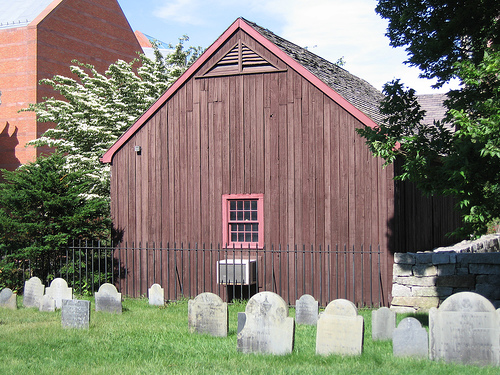
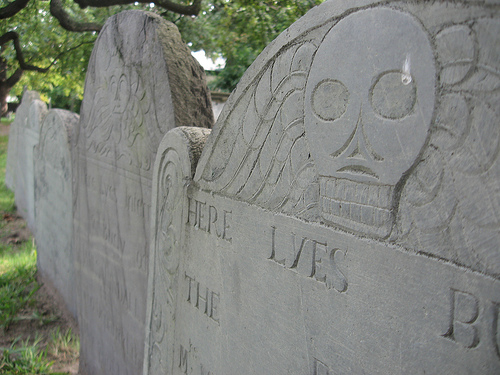
A period of atonement began in the colony following the release of the surviving accused witches. Samuel Sewall, one of the judges, issued a public confession of guilt and an apology. Several jurors came forward to say that they were "sadly deluded and mistaken" in their judgments. Reverend Samuel Parris conceded errors of judgment, but mostly shifted blame to others. Parris was replaced as minister of Salem village by Thomas Green, who devoted his career to putting his torn congregation back together. Governor Phips blamed the entire affair on William Stoughton. Stoughton, clearly more to blame than anyone for the tragic episode, refused to apologize or explain himself. He criticized Phips for interfering just when he was about to "clear the land" of witches. Stoughton became the next governor of Massachusetts.
As Mike and Bone heard about the gruesome story of religious intolerance they noticed that Salem, just had a bad "ju-ju" about it. It was definitely something that you could not see or hear, but feel.
Later, when the Boys related their story to other that had visited Salem, they too related that Salem has a "bad feel".
The Very Famous House of the Seven Gables in Salem
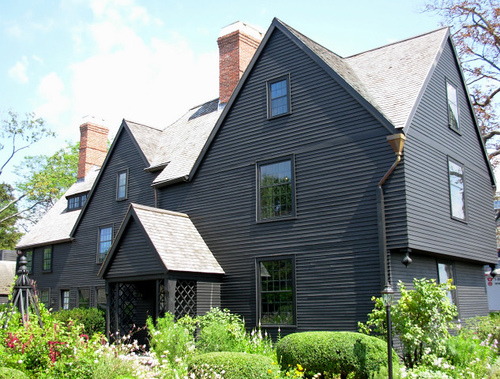
As the Boys headed back to their car, they walked down Turner Street where the famous House of the Seven Gables can be found. This home is the Turner-Ingersoll Mansion (built in 1668), and was the inspiration for Nathaniel Hawthorne's novel, named the House of the Seven Gables. Hawthorne, who was the great-grandson of John Hathorne, one of the judges whom executed the nineteen "Witches" in 1692. Nathaniel was so embarrassed by the family scandal that he added a "w" to his last name. Much of his writings was a refutation of the religious intolerance of his Great-Grandfather.
With the nasty taste of Salem around them, the Boys thought that they would leave icky, ooky, speaky, spooky of Salem and visit the Adams Family in Braintree !
The Adams Family ! John Adams Birthplace
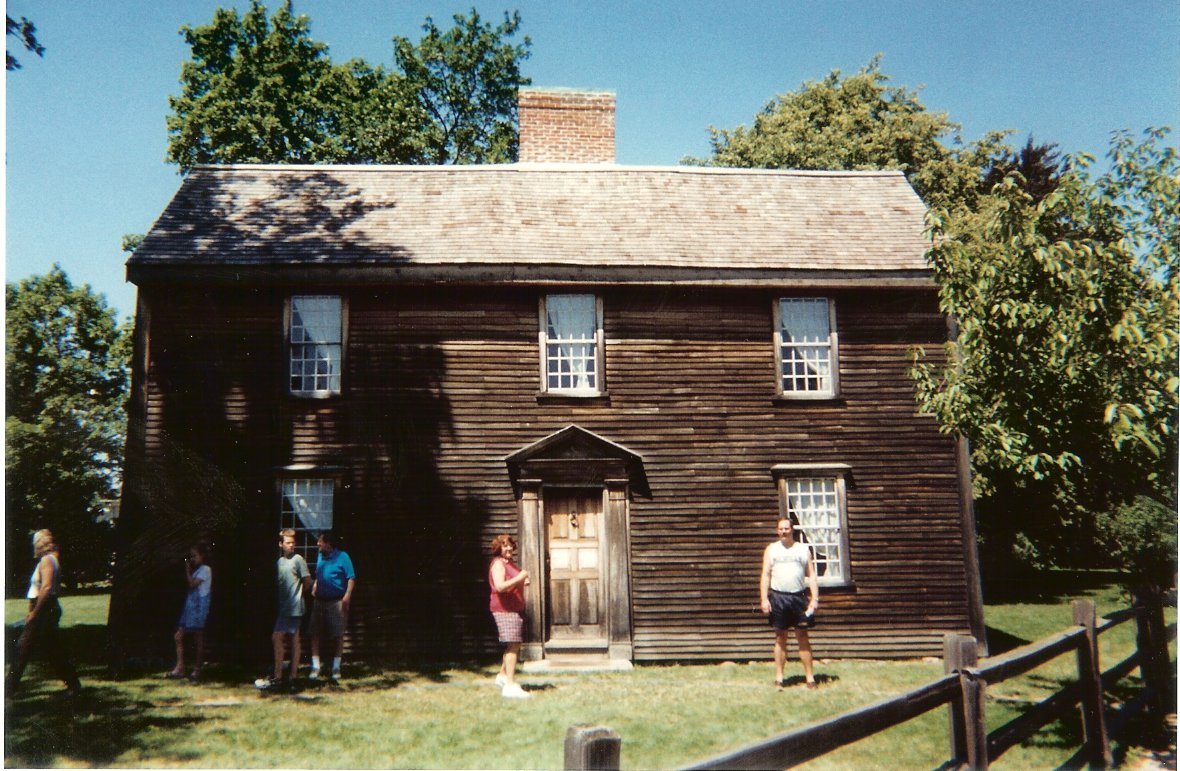
The Home of Two Presidents, Peacefield! The Home of John and John Quincy Adams!
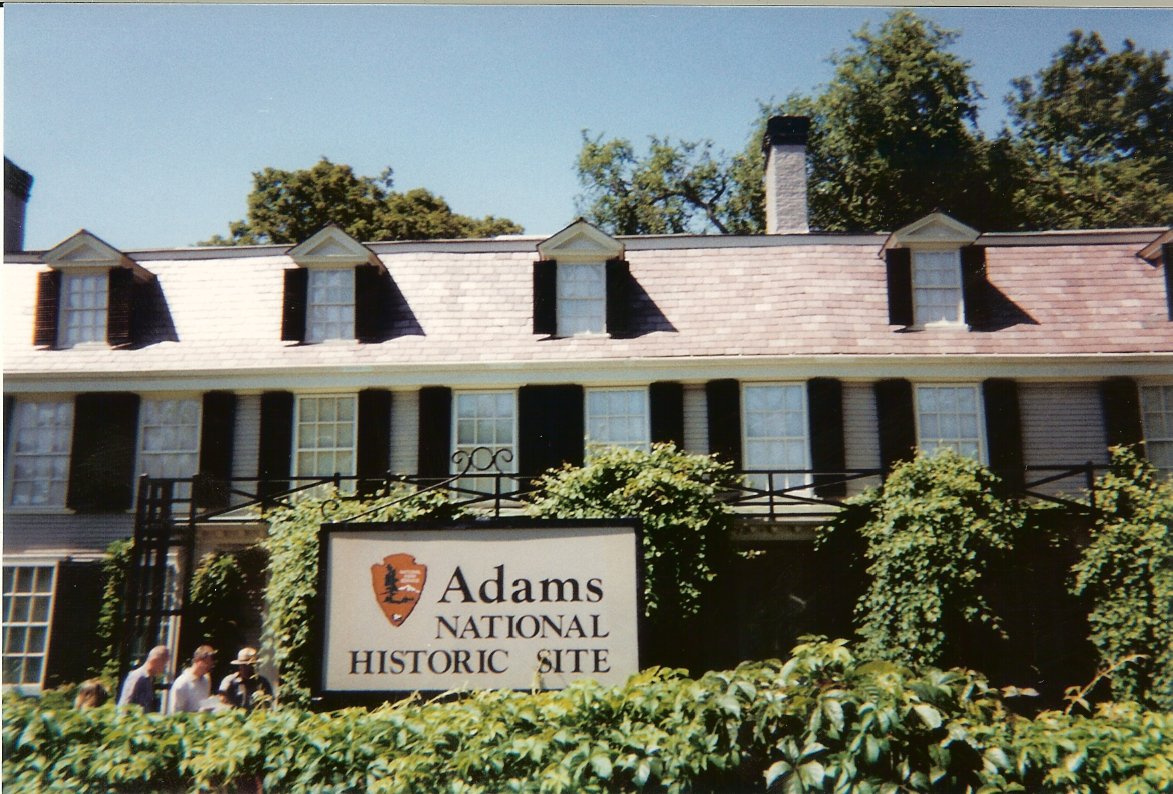
Just south of Boston the Mike and Bone stopped in Quincy at Peacefield, also called Old House, is a historic home formerly owned by second United States President John Adams, his son John Quincy Adams and other members of the Adams family, and is now part of the Adams National Historical Park.
Peacefield was the home and farm of John Adams (October 30, 1735 – July 4, 1826) author of the Constitution of the Commonwealth of Massachusetts, contributing author of the Constitution of the United States, first Vice President of the United States, and second President of the United States. Peacefield was also home to Adams' wife Abigail Smith Adams (November 11, 1744 – October 28, 1818) who is famous for her independence of thought and her correspondence with John Adams while he attended the Continental Congress in Philadelphia. Peacefield was also home to John Quincy Adams (July 11, 1767 – February 23, 1848) and his wife Louisa Catherine Adams, their son Charles Francis Adams (ambassador to the United Kingdom during the American Civil War), and historians Henry Adams and Brooks Adams, and of course Gomez, Morticia, and Lurch !!
A Presidential Visit for Mike and Bone!!
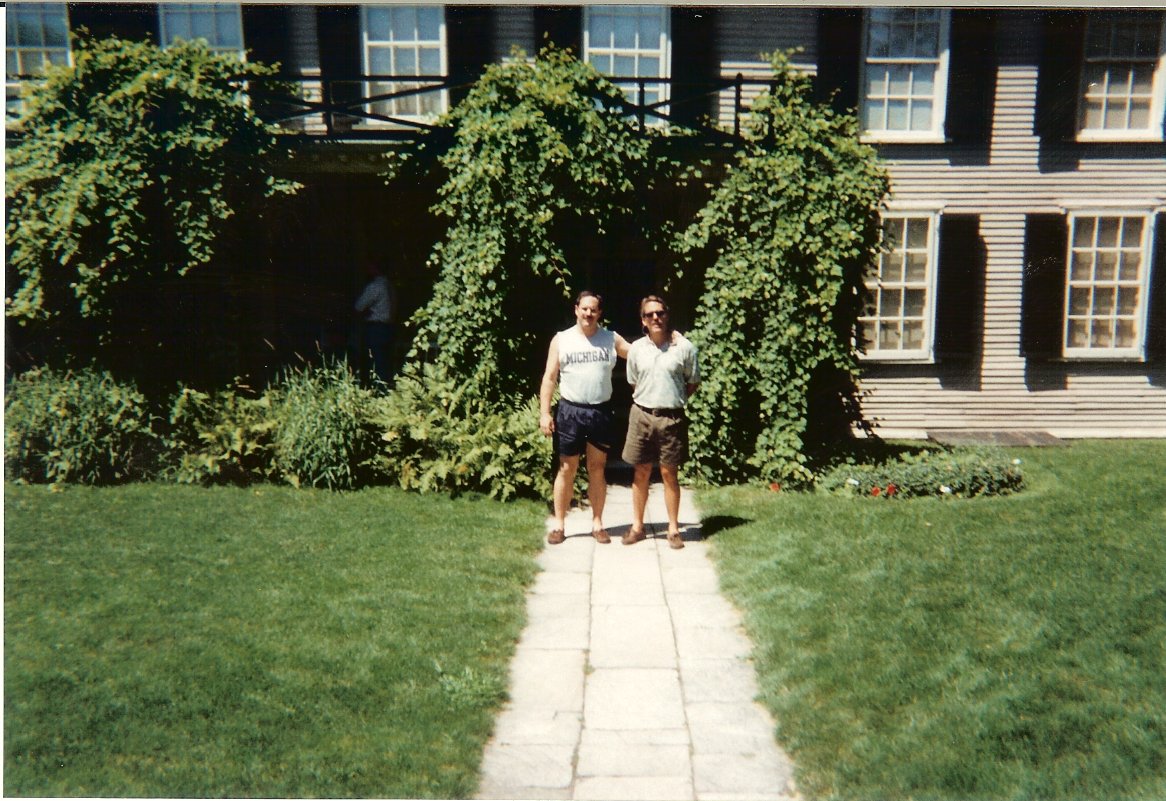
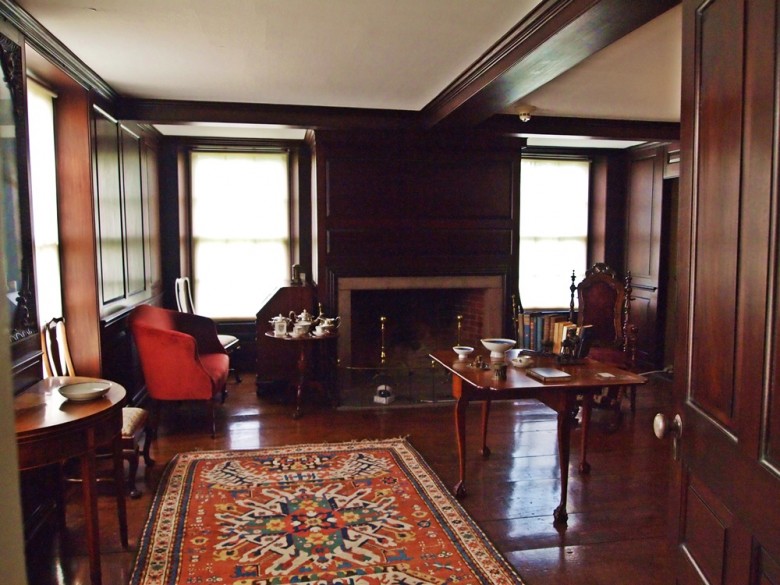
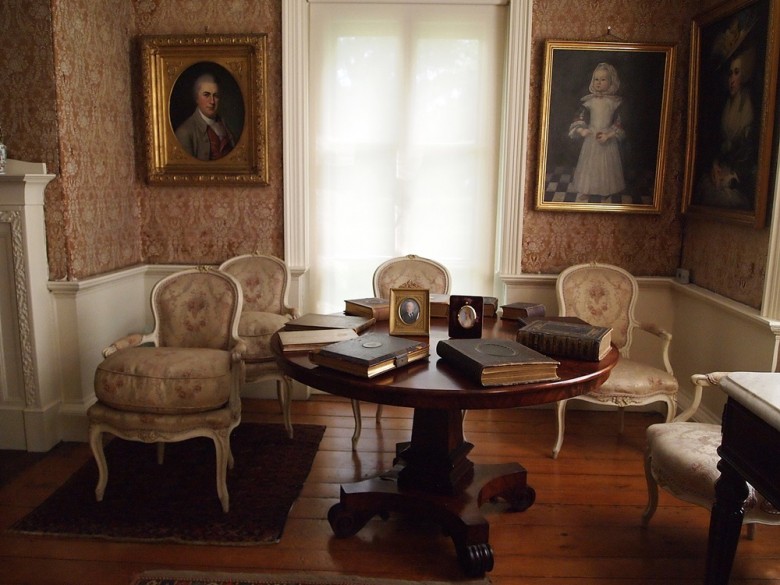
The oldest portion of the house was built in 1731 by Leonard Vassall, a sugar-planter from Jamaica, and acquired by John and Abigail Adams in 1787 after its loyalist owners had abandoned Massachusetts during the Revolutionary War. The Adams were at that time still resident in London, but returned in 1788 to occupy the house and its 40 acres of farmland and orchards. They were disagreeably surprised by the house, however, after their years in England. The house at that time consisted of only two low-ceilinged rooms on the ground floor, two bedrooms, and an attic. As Abigail Adams wrote, "it feels like a wren's nest".
During the subsequent 12 years, with Adams resident in Washington first as Vice President and then as President, Abigail Adams attended to the house and farm. She greatly expanded it, adding what is now the right side of the front facade, with a fine hallway and large parlor on the ground floor and a large study above. The additions were built in the Georgian style with a gambrel roof creating a nearly full attic story. Adams returned to the house full-time in 1801 after his defeat for a second presidential term. His son John Quincy Adams also returned to the house at that time, after completing his ambassadorial term in Berlin. Further extensions to the house were made by their son, Charles Francis Adams.
The house was given by the Adams family to the United States in 1946, and is now open to the public as part of the Adams National Historical Park operated by the National Park Service. Other nearby sites include the John Adams birthplace, John Quincy Adams birthplace, and United First Parish Church where both presidents are buried.
Lotsa Books in the Adams Library
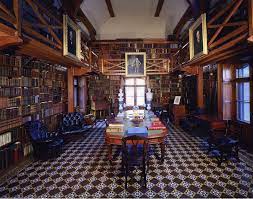
"Thomas Jefferson Lives" John Adams Last Words in this Chair July 4th, 1826
(50 Years to the Day he signed the Declaration of Independence!)
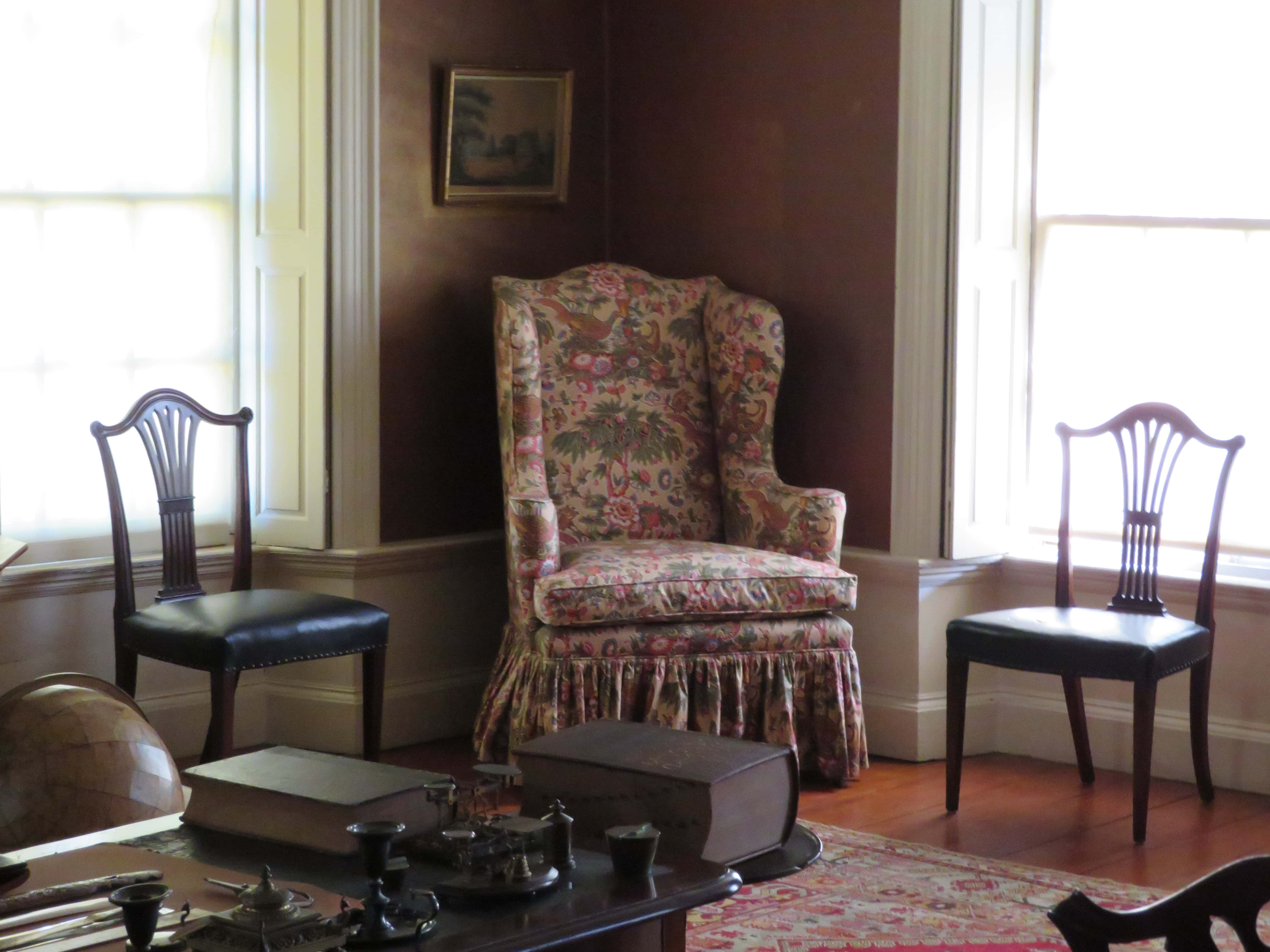
It was in this Parlour, on that chair on July 4, 1824, John Adams whispered his last words: "Thomas Jefferson survives." But Jefferson had died at Monticello a few hours earlier, 50 years to the day each had signed the Declaration of Independence! It was a further irony that John Adams son, John Q Adams was president at the time.
With the story of the 2nd and 6th presidents fresh in their tiny brains, the Boys thought that they would take a pilgrimage a further back in history down the coast in Plymouth !
Setting Sail on the Mayflower?!
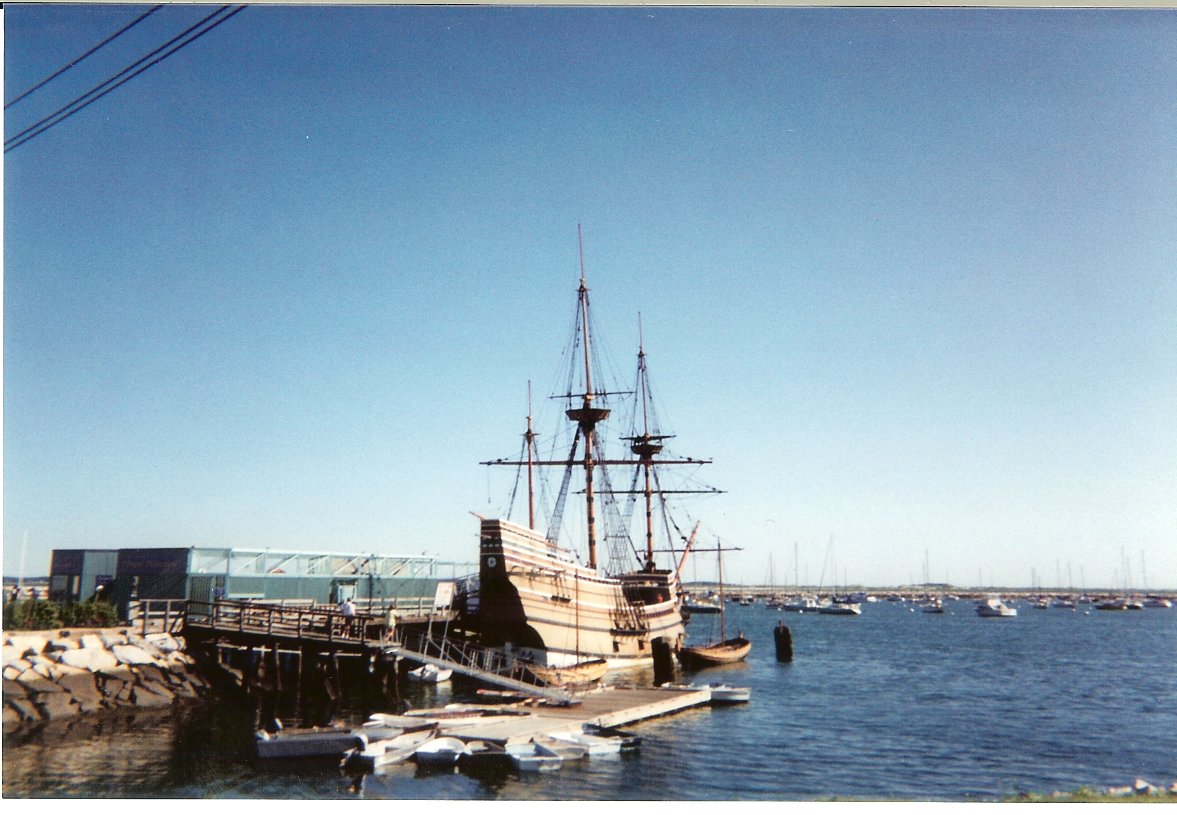
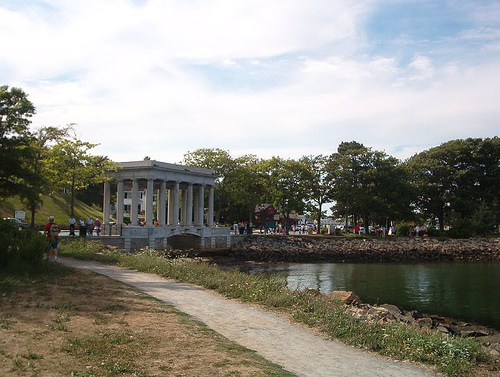
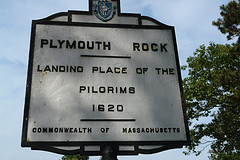

Mike and Bone made it to Plymouth early afternoon and started at the Pier to see the recreation of the Mayflower and get stoned at Plymouth Rock.
Mike and Bone, Rocking at Plymouth
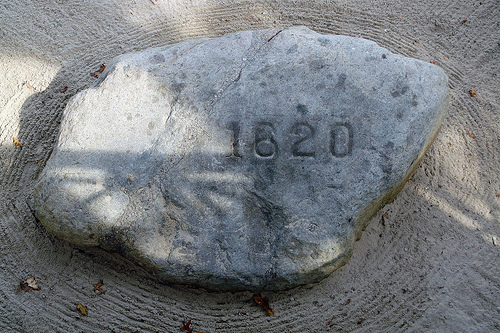
As Mike and Bone oggled at the Rock they didn't realize that there are no contemporary references to the Pilgrims' landing on a rock at Plymouth. There are two primary sources written by the Pilgrims themselves describing the landing in Plymouth in 1620, William Bradford's journal of Plymouth Plantation and the 1622 book popularly known as Mourt's Relation. Both simply say that the Pilgrims landed. Neither mentions any rocks in their account of the landing. The first references to Plymouth Rock are found over 100 years after the actual landing. With this knowledge the Boys were wondering what the huge pavilion and wrought iron was about !
Site-Seeing Samoset !
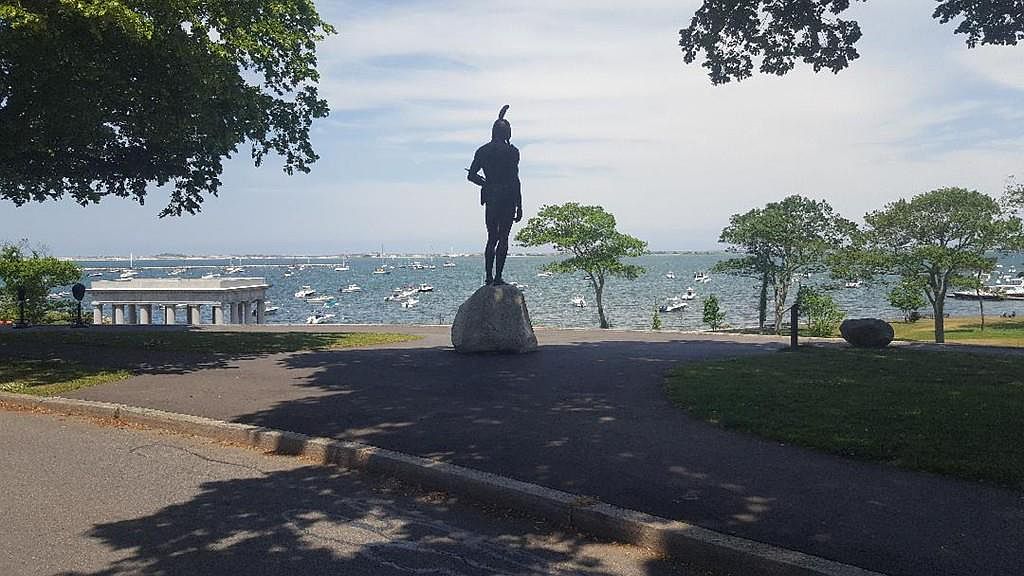
As the Boys wandered around town they wondered:
Who the heck were the Pilgrims anyways ?!? The Pilgrims were English Separatists who founded Plymouth Colony in 1620. In the first years of the 17th century, small numbers of English Puritans broke away from the Church of England because they felt that it had not completed the work of the Reformation. They committed themselves to a life based on the Bible. Most of these Separatists were farmers, poorly educated and without social or political standing. One of the Separatist congregations was led by William Brewster and the Rev. Richard Clifton in the village of Scrooby in Nottinghamshire. The Scrooby group emigrated to Amsterdam in 1608 to escape harassment and religious persecution. The next year they moved to Leiden, where, enjoying full religious freedom, they remained for almost 12 years. In 1617, discouraged by economic difficulties, the pervasive Dutch influence on their children, and their inability to secure civil autonomy, the congregation voted to emigrate to America. Through the Brewster family's friendship with Sir Edwin Sandys, treasurer of the London Company, the congregation secured two patents authorizing them to settle in the northern part of the company's jurisdiction. Unable to finance the costs of the emigration with their own meager resources, they negotiated a financial agreement with Thomas Weston, a prominent London iron merchant. Fewer than half of the group's members elected to leave Leiden. A small ship, the Speedwell, carried them to Southampton, England, where they were to join another group of Separatists and pick up a second ship. After some delays and disputes, the voyagers regrouped at Plymouth aboard the 180-ton Mayflower. It began its historic voyage on Sept. 16, 1620, with about 102 passengers--fewer than half of them from Leiden. After a 65-day journey, the Pilgrims sighted Cape Cod on November 19. Unable to reach the land they had contracted for, they anchored (November 21) at the site of Provincetown. Because they had no legal right to settle in the region, they drew up the Mayflower Compact, creating their own government. The settlers soon discovered Plymouth Harbor, on the western side of Cape Cod Bay and made their historic landing on December 21; the main body of settlers followed on December 26. The term Pilgrim was first used by William Bradford to describe the Leiden Separatists who were leaving Holland. The Mayflower's passengers were first described as the Pilgrim Fathers in 1799. Learning about all this was thirsty work, which drove the Boys to find a good olde english pub for a pint!
Searching for a Pub in Plymouth's City Center!
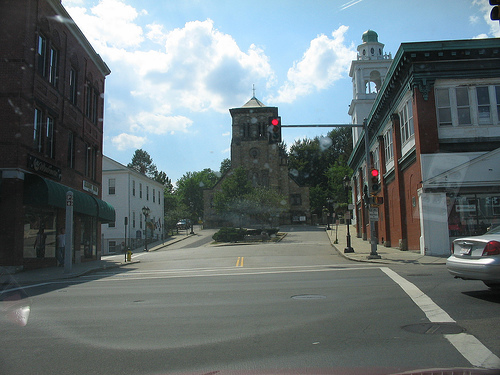
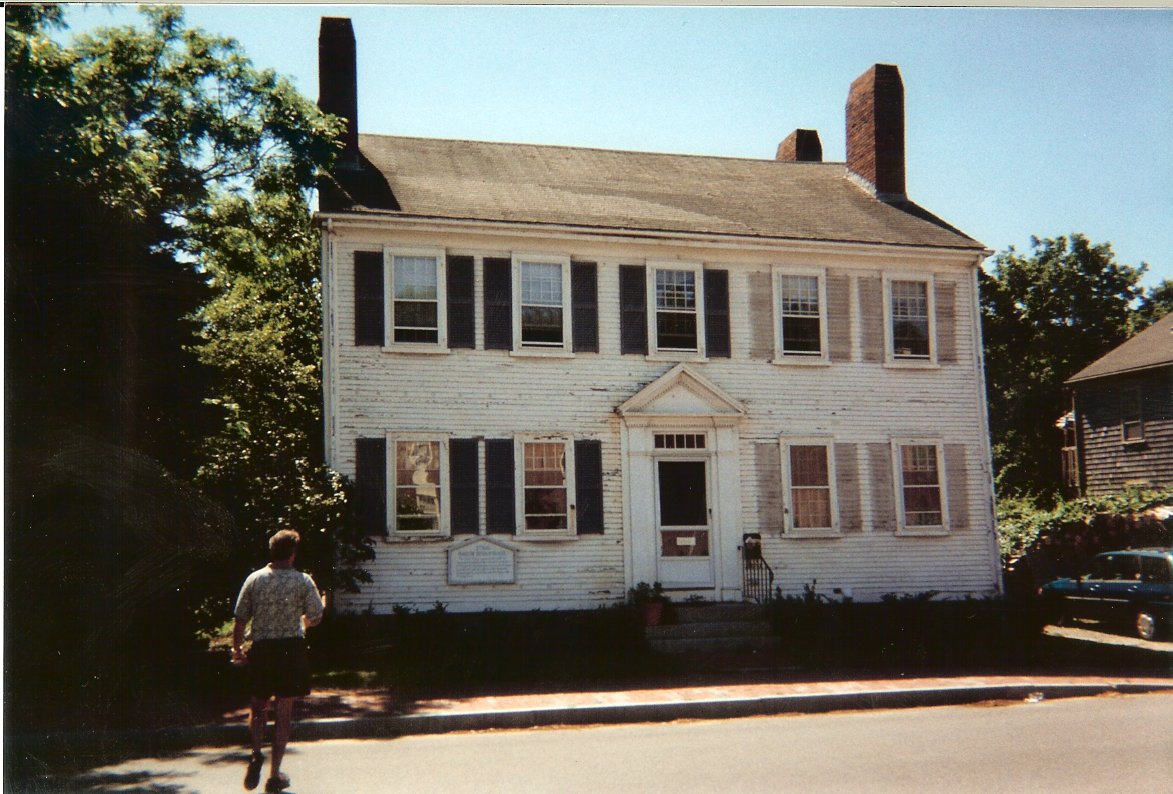
While looking for a beer Bone related to Mike that after landing at Plymouth (so named by Captain John Smith earlier), outside of the land controlled by the London Virginia Company which had been allotted to them by patent, the Pilgrims and others aboard sought to forestall problems of governance arising in the colony. Knowing that earlier settlements in the New World had failed due to a lack of government, the Mayflower Compact was written and adopted.
The Mayflower Compact was based simultaneously upon a majoritarian model and the settlers' allegiance to the king. It was in essence a social contract in which the settlers consented to follow the compact's rules and regulations for the sake of survival. The government that the compact formed, in return, would derive its power from the consent of the governed. The compact is often referred to as the foundation of the Constitution of the United States.
A Monument to the Pilgrims
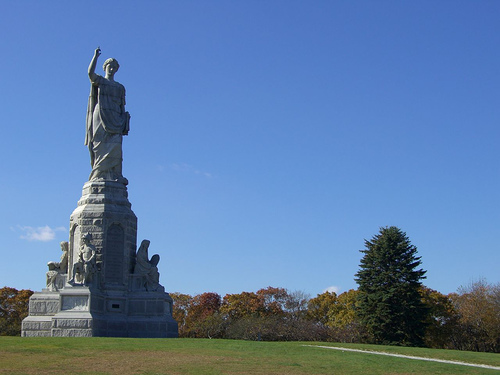
Text of the Mayflower Compact
"In the name of God, Amen. We whose names are underwritten, the loyal subjects of our dread Sovereign Lord King James, by the Grace of God of Great Britain, France and Ireland, King, Defender of the Faith, etc. Having undertaken, for the Glory of God and advancement of the Christian Faith and Honour of our King and Country, a Voyage to plant the First Colony in the Northern Parts of Virginia, do by these presents solemnly and mutually in the presence of God and one of another, Covenant and Combine ourselves together into a Civil Body Politic, for our better ordering and preservation and furtherance of the ends aforesaid; and by virtue hereof to enact, constitute and frame such just and equal Laws, Ordinances, Acts, Constitutions and Offices, from time to time, as shall be thought most meet and convenient for the general good of the Colony, unto which we promise all due submission and obedience. In witness whereof we have hereunder subscribed our names at Cape Cod, the 11th of November, in the year of the reign of our Sovereign Lord King James, of England, France and Ireland the eighteenth, and of Scotland the fifty-fourth. Anno Domini 1620."
As the Boys wandered around town sampling beers in the many establishments, the conversation went from history, to politics and naturally to religion !
Dickering with the Clergy in the first Unitarian Church in the US


As the Boys wandered around town, the conversation went from history, to politics and naturally to religion ! Checking out the Church in City Center, the Boys encountered the Minister of the Church. Once the Minister was convinced that the Boys weren't going to rob them, that all had a lovely chat on the mysteries of the next live. Being and Apathetic-Agnostic (don't know-don't care) Bone gave the minister grief on the "Counting conundrum in Genesis.
You know where Adam was the first person, then Eve, they had to kids, Cain and Abel. Cain slew Abel (who obviously was that able!),, was banished by Adam and Eve, left them crossed into the Bekaa Valley, went into a Village and married a women. Somewhere the math just "dont't" add up!!
The Minister wisely (or cowardly!) side-steped that simple logical question, and soon after ushered the Boys out of the Church, whereas the Boys wandered into the Churches Graveyard, marveling at the headstone dated back to the 1600's !
Pilgrims of Grave Concern
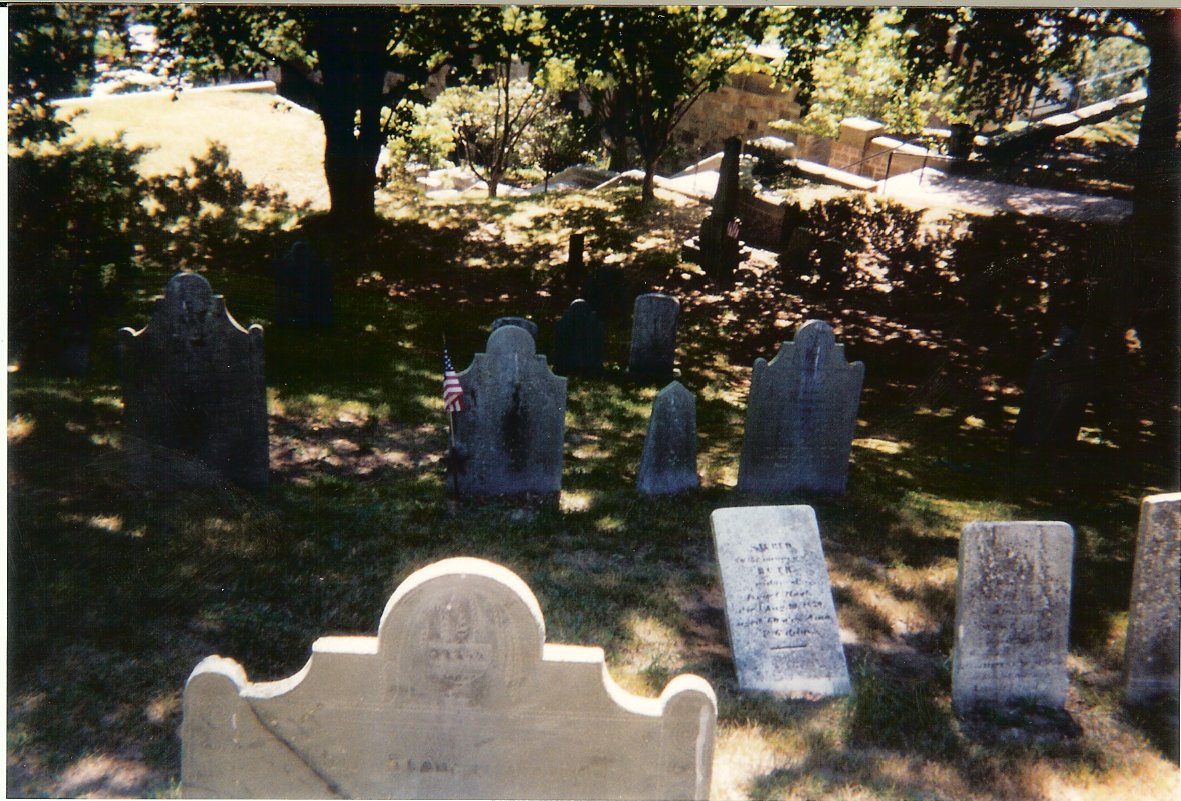
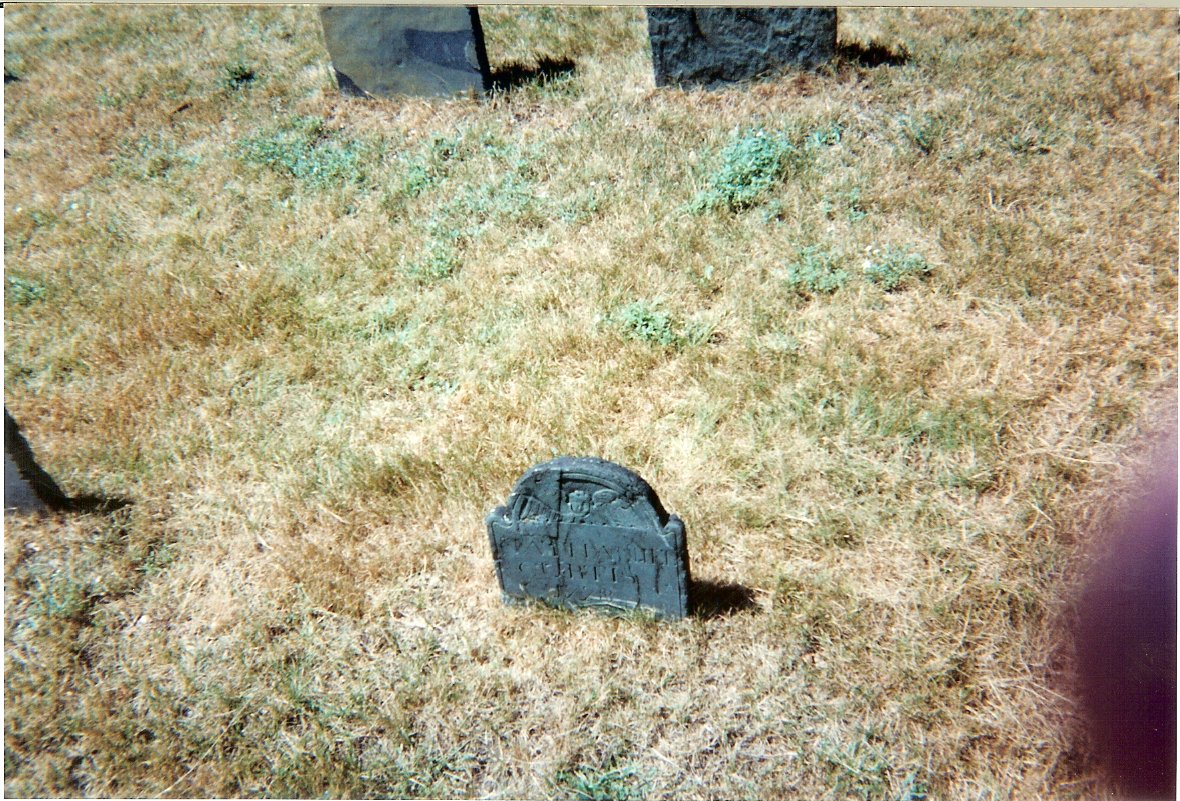
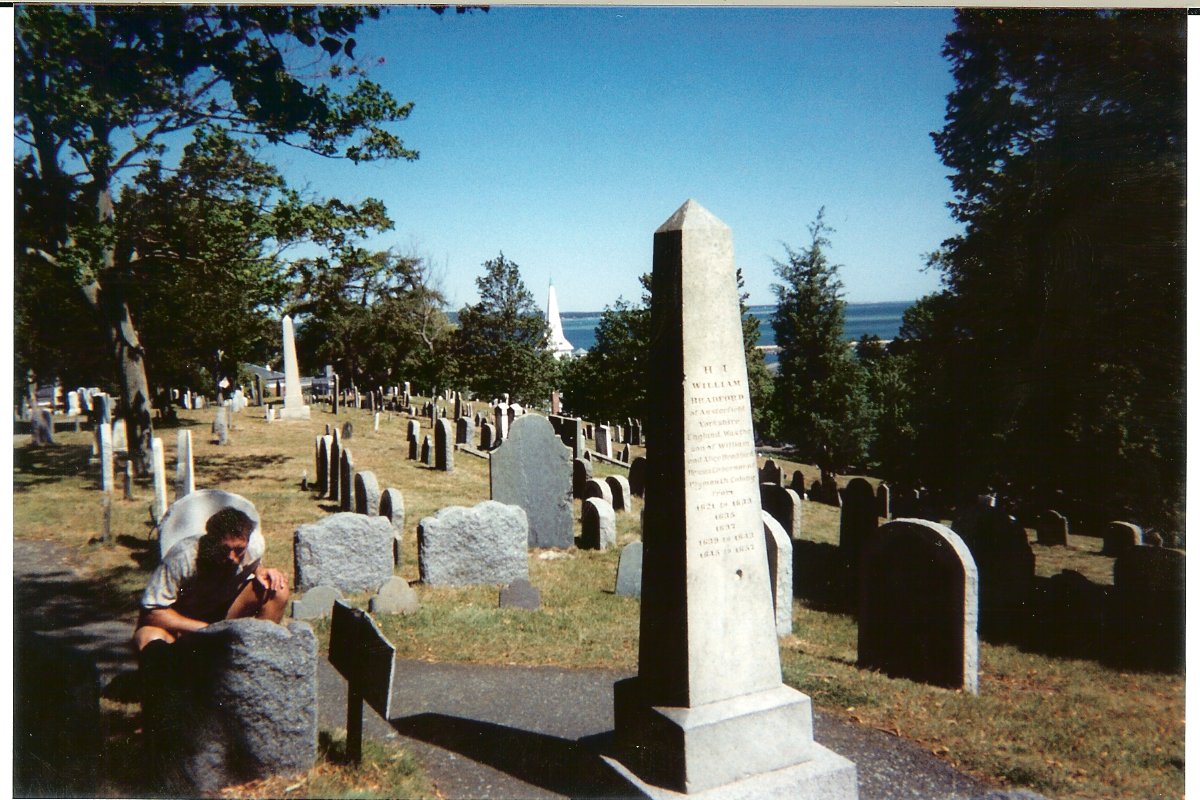

By 4:00PM Mike and Bone had pretty much covered everything you would want to check out in historic Plymouth, with sites such as Plymouth Rock and the Mayflower, so the boys pondered their next strategic move!
A view of the Atlantic Coast from Plymouth
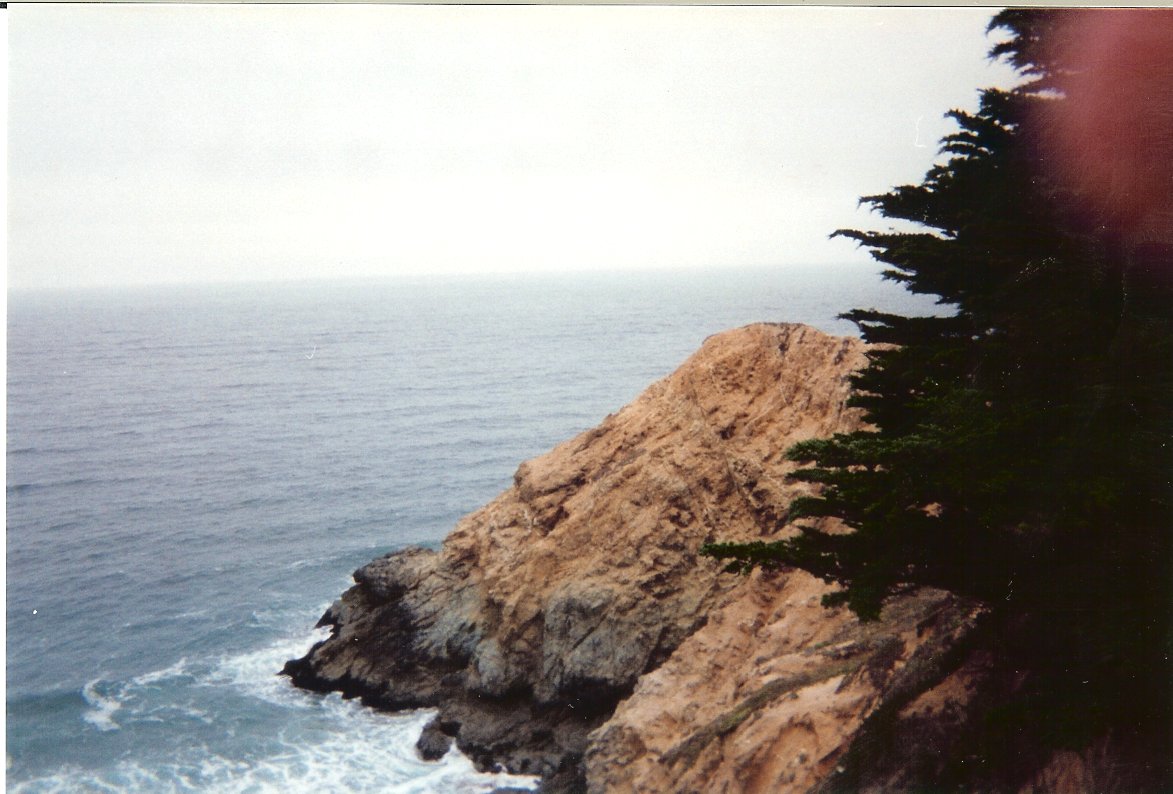
When you think about New England, what is one of spot you think about? Was is that part that makes Massachusetts's look like a fishhook? Well Cape Cod of course !! With the boys just mile from the entrance to the Cape, they thought what better place to end the day than at the tip of New England, Province Town !!
A Bone looking for fish just for the Halibut on Cape Cod National Seashore !
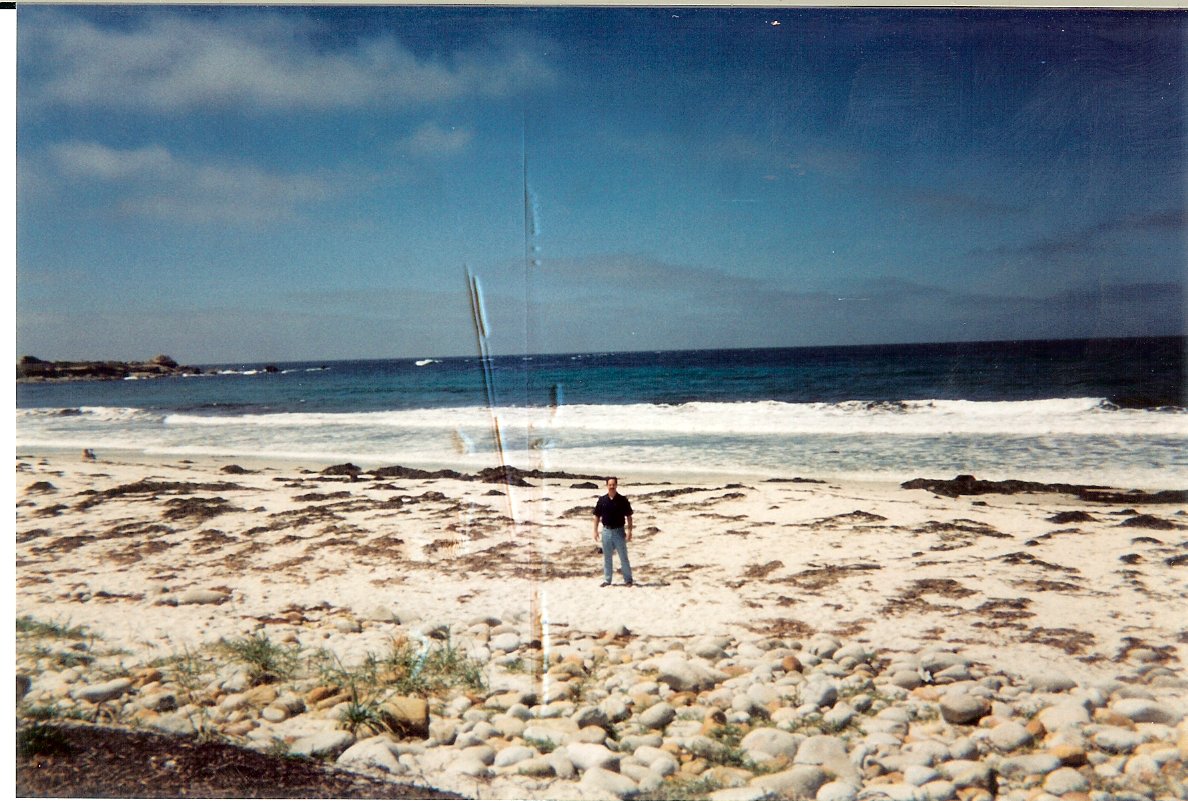
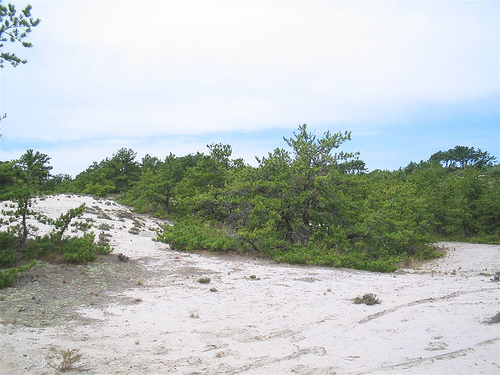
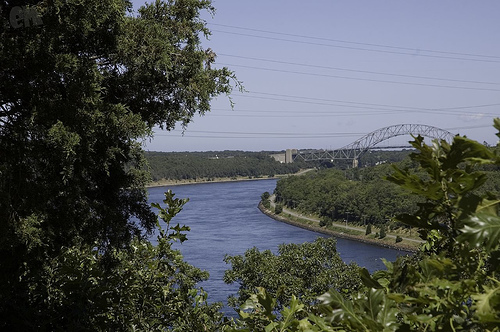
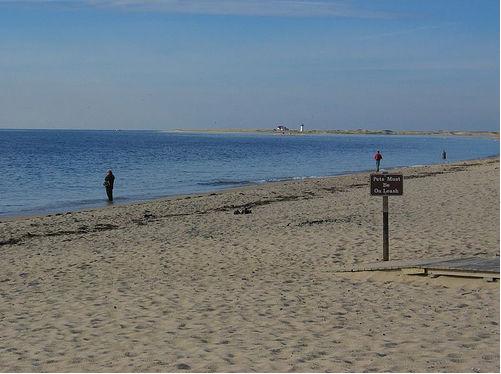
It turns out Cape Cod is a pretty big Cape !! It takes almost two hours to drive from the entrance to P-Town (as the locals call it.) As the Boys were driving up, they started to worry about finding lodging, so when they crossed a National Park Tourist Station, they stopped for info.
The Park Rangers were quite unhelpful as the Boys were to find out. They assured Mike and Bone that there were plenty of Room, and even gave the Boys the number to a Motel 6 which was the VERY end of the Cape.
Plus, they mentioned that P-Town had been settled by Portuguese Fisherman, there were great Portuguese Restaurants !
It was perfect !!! Exactly what the Boys were looking for, new food (Portuguese), an eclectic motel at the end. and a kool party town !!!
Yep! Mike and Bone were gonna make P-Town stand for "Party !!"
The Sun setting as the Boys make it to P-Town!

Using their cell phones the Boys booked a room at the Motel 6 (not nearly as cool and Kathleen Kennedy's Bunkhouse in Maine)
Looking at the brochure on P-Town Portuguese restaurants, they noticed that the one that seemed to be the most recommended was right next door to their Motel, yet more good news!!!
This night was gonna be one heckuva good night !!
After checking in, Mike and Bone immediately walked over to the Portuguese Restaurant, were seated discovered that their waiter was not from Portugal, but more likely from San Francisco. NOT that there is anything wrong with that ! Plus, you find Gays quite often in the Service Industry in Tourist Towns, hey look at Key West !
Sadly, Portuguese food wasn't' really all that fancy, different, or good, and left no impression on the Boys, so by 8:00 PM, they left the Restaurant and their new admirer "Gus," and were ready to PARTY !!!
Overly "Provincial" Province Town

W"Err, Mike, where's the Babes !!??!! Walking into downtown P-Town, which was now completely dark but very crowded, it took a few minutes for their eyes to adjust. They started to bop in and quickly bop out of all the bars, because they didn't see no women?! They then noticed that there were no women,,,, ANY where in the crowded streets !!!?!!!
With a dawning horror of realization, Mike and Bone now realized what the Park Ranger didn't tell them about P-Town, the "P" doesn't stand for Province, Portuguese, or even Party,,,,,it stands for "Princess" !!!!
They finally realized that P-Town is all Gay !!! (Not, that there is anything wrong with that!) The Boys had a "Gay" old time in P-Town !?!
The Boys had a "Gay" old time in P-Town!?!
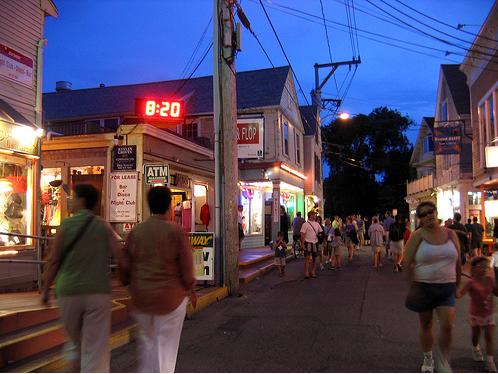
After the shocking turn of events, Mike and Bone decided to call it an early night at the unheard of time of 10:00PM !!
It had been a long day anyways, they certainly were not going to find anybody to flirt with (or that they would want to flirt with !), so with some trepidation they went to the Motel 6. On the way back to their room, the Boys stopped at a Hardware Store, bought two rolls of duct tape, and applied liberally to their rear ends in case a of rampaging horde of gays broke into their room !
Hey !! it could happen !!
And you can't be too careful you know !!!